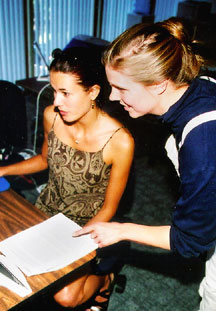|
(page 2 of 2)
Twelve Ready Educators
The newest component of TSRI’s educational outreach
is the Science Partnership Scholars Program. Each year since
its inception in 1999, 12 middle and high school science teachers
from throughout San Diego County are selected to attend the
six-week program, comprised of a Saturday orientation and
Tuesday after-school sessions on the TSRI campus. Under the
supervision of Professor Elizabeth Getzoff, a group of graduate
students has developed a curriculum which includes hands-on
experiments that teachers can use in their classrooms, as
well as presentations on state-of-the-art research topics
and techniques.
The day I visit the Scholars Program, Gerald Joyce, professor
in the Department of Molecular Biology, is well into an engaging
presentation on Darwinian evolution at the molecular level.
Twelve middle and high school teachers sit in various poses
around a large conference table scattered with briefcases,
coffee cups, cookie remnants, and water bottles. With eyes
fixed on Dr. Joyce, the teachers are attentive and alert—the
perfect pupils.
"One of the things I would like to see conveyed to students,"
he tells them, "is that evolutionary changes are purely chemical.
There’s nothing controversial in that itself."
Later, after Dr. Joyce has left and graduate student Eugene
Wu has taken over, the discussion veers into Evolution vs.
Creation territory, and how these teachers deal with the topic
in their classrooms. Some parents get upset if the theory
of evolution is presented to their children, notes one teacher.
Sarah Allen Peddie, biology teacher at Kearny High School,
shares her recent approach that involves setting up a mock
trial and assigning half the class to argue Evolution and
the other, Creation. The important thing to convey, Eugene
stresses, is that science doesn't prove things; the work of
science is to put forth hypotheses, and from there to amass
data that either discounts or supports them.
It is now 6 PM and well past the tutorial’s scheduled
end. By way of closing, Eugene comments: "You are on the front
lines of this issue and I admire you for that. You are the
most important scientists in this regard." He adds that he
had planned to discuss how microbes reproduce clonally, but
since they’ve run overtime, he can give them notes instead.
The teachers protest— "Go on, go on."
I walk to the parking lot with Joanne Mons Johnson, who
teaches advanced placement (AP) biology, marine science, and
algebra at Kearny High. I ask her what it’s like to be
taught by graduate students. "They have a freshness and a
generosity of spirit, " Joanne tells me. "They have a greater
knowledge than we do, but share it in a way that really honors
us."
Cultivating the Garden
The common thread that ties together TSRI’s Spring
Enrichment Tutorials and Science Partnership Scholars Program
is the aim to bridge the gap between the research that goes
on in modern laboratories and the curriculum presented in
high school science classrooms. The end goals are to provide
students with a relevant education on some issues in science
that will affect their lives, and to relay a sense of the
vibrancy and excitement of research at the cutting-edge of
biology and chemistry.
Spring is upon us at TSRI. Fresh faces, budding scientists,
ripening pursuits.
1 | 2 |

|

Maria Mendez (left), science teacher
at Wilson Middle School, and Beth Stroupe, TSRI graduate student
and Scholars Program coordinator, look at protein structures
using the RalMol program.
|

